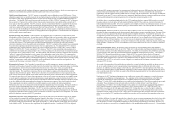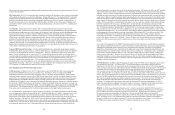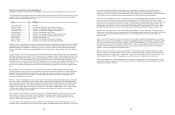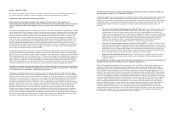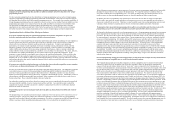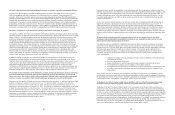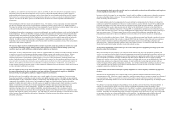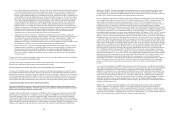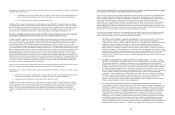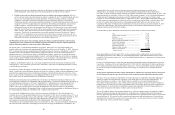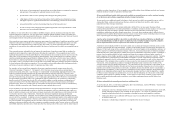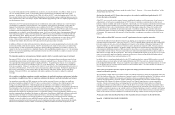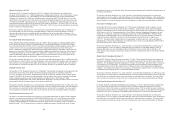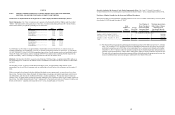Dish Network 2012 Annual Report Download - page 23
Download and view the complete annual report
Please find page 23 of the 2012 Dish Network annual report below. You can navigate through the pages in the report by either clicking on the pages listed below, or by using the keyword search tool below to find specific information within the annual report.34
34
Furthermore, the fair values of wireless licenses and related assets may vary significantly in the future. In particular,
valuation swings could occur if:
x consolidation in the wireless industry allows or requires wireless carriers to sell significant portions of
their wireless spectrum holdings, which could in turn reduce the value of our spectrum holdings; or
x a sale of spectrum by one or more wireless providers occurs.
In addition, the fair value of wireless licenses could decline as a result of the FCC’s pursuit of policies, including
auctions, designed to increase the number of wireless licenses available in each of our markets. If the fair value of
our 2 GHz licenses were to decline significantly, the value of these licenses could be subject to impairment charges.
We assess potential impairments to our indefinite-lived intangible assets annually or more often if indicators of
impairment arise to determine whether there is evidence that indicate an impairment condition may exist.
We made a substantial investment to acquire certain 700 MHz wireless spectrum licenses and will be required to
make significant additional investments or partner with others to commercialize these licenses.
In 2008, we paid $712 million to acquire certain 700 MHz wireless spectrum licenses, which were granted to us by
the FCC in February 2009. These licenses mandate certain interim and final build-out requirements. By June 2013,
we must provide signal coverage and offer service to at least 35% of the geographic area in each area covered by
each individual license (the “700 MHz Interim Build-out Requirement”). By the end of our license term (June
2019), we must provide signal coverage and offer service to at least 70% of the geographic area in each area covered
by each individual license (the “700 MHz Final Build-out Requirement”). We have recently notified the FCC of our
plans to commence signal coverage in select cities within certain of these areas, but we have not yet developed plans
for providing signal coverage and offering service in all of these areas. If we fail to meet the 700 MHz Interim
Build-out Requirement, the term of our licenses will be reduced, from June 2019 to June 2017, and we could face
possible fines and the reduction of license area(s). If we fail to meet the 700 MHz Final Build-out Requirement, our
authorization for each license area in which we fail to meet the requirement will terminate. To commercialize these
licenses and satisfy the associated FCC build-out requirements, we will be required to make significant additional
investments or partner with others. Depending on the nature and scope of such commercialization and build-out,
any such investment or partnership could vary significantly.
There can be no assurance that we will be able to develop and implement a business model that will realize a return
on these investments and profitably deploy the spectrum represented by the 700 MHz licenses.
Furthermore, the fair values of wireless licenses may vary significantly in the future. In particular, valuation swings
could occur if:
x consolidation in the wireless industry allows or requires wireless carriers to sell significant portions of their
wireless spectrum holdings, which could in turn reduce the value of our spectrum holdings; or
x a sudden large sale of spectrum by one or more wireless providers occurs.
In addition, the fair value of wireless licenses could decline as a result of the FCC’s pursuit of policies, including
auctions, designed to increase the number of wireless licenses available in each of our markets. If the fair value of
our 700 MHz licenses were to decline significantly, the value of these licenses could be subject to impairment
charges. We assess potential impairments to our indefinite-lived intangible assets annually or more often if
indicators of impairment arise to determine whether there is evidence that indicate an impairment condition may
exist.
35
35
To the extent we commercialize our wireless spectrum licenses, we will face certain risks entering and competing
in the wireless services industry and operating a wireless services business.
We will likely be required to make significant additional investments or partner with others to, among other things,
finance the commercialization and build-out requirements of our wireless spectrum licenses and our integration
efforts including compliance with regulations applicable to these licenses. Depending upon the nature and scope of
such commercialization, build-out and integration efforts, any such investment could vary significantly.
Additionally, recent consolidation in the wireless telecommunications industry, may, among other things, limit our
available options, including our ability to partner with others. There can be no assurance that we will be able to
develop and implement a business model that will realize a return on these spectrum investments or that we will be
able to profitably deploy the assets represented by these spectrum investments, which may affect the carrying value
of these assets and our future business, results of operations and financial condition.
To the extent we commercialize our wireless spectrum licenses and enter the wireless services industry, a wireless
services business presents certain risks. Any of the following risks, among others, may have a material adverse
effect on our future business, results of operations and financial condition.
x The wireless services industry is competitive and maturing. We have limited experience in the wireless
services industry, which is a competitive and maturing industry with incumbent and established
competitors such as AT&T, Verizon, T-Mobile and Sprint. These companies have substantial market share
and have more wireless spectrum assets than us. Some of these companies have greater financial,
marketing and other resources than us, and have existing cost and operational advantages that we lack.
Market saturation is expected to continue to cause the wireless services industry’s customer growth rate to
moderate in comparison to historical growth rates, leading to increased competition for customers. As the
industry matures, competitors increasingly must seek to attract a greater proportion of new subscribers from
each other’s existing subscriber bases rather than from first-time purchasers of wireless services. In
addition, the cost of attracting a new customer is generally higher than the cost associated with retention of
an existing customer.
x Our ability to compete effectively would be dependent on a number of factors. Our ability to compete
effectively would depend on, among other things, our network quality, capacity and coverage; the pricing
of our products and services; the quality of customer service; our development of new and enhanced
products and services; the reach and quality of our sales and distribution channels; and capital resources. It
would also depend on how successfully we anticipate and respond to various competitive factors affecting
the industry, including, among others, new technologies and business models, products and services that
may be introduced by competitors, changes in consumer preferences, the demand for services, demographic
trends, economic conditions, and discount pricing and other strategies that may be implemented by
competitors. It may be difficult for us to differentiate our products and services from other competitors in
the industry, which may limit our ability to attract customers. Our success also may depend on our ability
to access and deploy adequate spectrum, deploy new technologies and offer attractive services to
customers. For example, we may not be able to obtain and offer certain technologies or features that are
subject to competitor patents or other exclusive arrangements.
x We would depend on third parties to provide us with infrastructure and products and services. We
would depend on various key suppliers and vendors to provide us, directly or through other suppliers, with
infrastructure, equipment and services, such as switch and network equipment, handsets and other devices
and equipment that we would need in order to operate a wireless services business and provide products
and services to our customers. For example, handset and other device suppliers often rely on one vendor
for the manufacture and supply of critical components, such as chipsets, used in their devices. If these
suppliers or vendors fail to provide equipment or services on a timely basis or fail to meet performance
expectations, we may be unable to provide products and services as and when expected by our customers.
Any difficulties experienced with these suppliers and vendors could result in additional expense and/or
delays in introducing our wireless services. Our efforts would involve significant expense and require
strategic management decisions on, and timely implementation of, equipment choices, network deployment
and management, and service offerings. In addition, these suppliers and vendors may also be subject to


